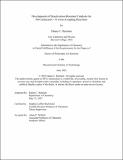Development of Deactivation-Resistant Catalysts for Pd-Catalyzed C–N Cross-Coupling Reactions
Author(s)
Reichert, Elaine C.
DownloadThesis PDF (12.64Mb)
Advisor
Buchwald, Stephen Leffler
Terms of use
Metadata
Show full item recordAbstract
Chapter 1: Introduction to Pd-Catalyzed C–N Cross-Coupling: Rational Biarylphosphine Ligand Design Enhances the Reactivity of Difficult Substrates
Transition-metal-catalyzed C−N cross-coupling reactions are an important class of transformations with applications in a variety of fields, and Pd-based catalysts are among the most effective for these reactions. However, certain classes of compounds, including very bulky substrates as well as those containing coordinating functional groups, can be very difficult to couple. The choice of the supporting ligand on Pd plays an important role in the efficiency of a given reaction, since the ligand is necessary to facilitate the productive coupling reaction and hinder the formation of off-cycle Pd species. Correspondingly, the Buchwald lab has enabled challenging transformations by rationally designing new biarylphosphine ligands.
Chapter 2: Development of an Aryl Amination Catalyst with Broad Scope Guided by Consideration of Catalyst Stability
A new dialkylbiaryl monophosphine ligand, GPhos, that supports a palladium catalyst capable of promoting carbon–nitrogen cross-coupling reactions between a variety of primary amines and aryl halides, was developed; in many cases, these reactions can be carried out at room temperature. The reaction development was guided by the idea that the productivity of catalysts employing BrettPhos-like ligands is limited by their lack of stability at room temperature. Specifically, it was hypothesized that primary amine and N-heteroaromatic substrates can displace the phosphine ligand, leading to the formation of catalytically dormant palladium complexes that reactivate only upon heating. This notion was supported by the synthesis and kinetic study of a putative off-cycle Pd complex. Consideration of this off-cycle species, together with the identification of substrate classes that are not effectively coupled at room temperature using previous catalysts, led to the design of a new dialkylbiaryl monophosphine ligand. An Ot-Bu substituent was added ortho to the dialkylphosphino group of the ligand framework to improve the stability of the most active catalyst conformer. To offset the increased size of this substituent, we also removed the para i-Pr group of the non-phosphorus-containing ring, which allowed the catalyst to accommodate binding of even very large α-tertiary primary amine nucleophiles. In comparison to previous catalysts, the GPhos-supported catalyst exhibits better reactivity both under ambient conditions and at elevated temperatures. Its use allows for the coupling of a range of amine nucleophiles, including (1) unhindered, (2) five-membered-ring N-heterocycle-containing, and (3) α-tertiary primary amines, each of which previously required a different catalyst to achieve optimal results.
Chapter 3: Pd-Catalyzed Amination of Base-Sensitive Five-Membered Heteroaryl Halides with Aliphatic Amines
A versatile and functional-group-tolerant method was developed for the Pd-catalyzed C–N cross-coupling of five-membered heteroaryl halides with primary and secondary amines, an important but underexplored transformation. Coupling reactions of challenging, pharmaceutically relevant heteroarenes, such as 2-H-1,3-azoles, are reported in good-to-excellent yields. High-yielding coupling reactions of a wide set of five-membered heteroaryl halides with sterically demanding α-branched cyclic amines and acyclic secondary amines are reported for the first time. The key to the broad applicability of this method is the synergistic combination of (1) the moderate-strength base NaOTMS, which limits base-mediated decomposition of sensitive five-membered heteroarenes that ultimately leads to catalyst deactivation, and (2) the use of a GPhos-supported Pd catalyst, which effectively resists heteroarene-induced catalyst deactivation while promoting efficient coupling, even for challenging and sterically demanding amines. Cross-coupling reactions between a wide variety of five-membered heteroaryl halides and amines are demonstrated, including eight examples involving densely functionalized medicinal chemistry building blocks.
Date issued
2023-06Department
Massachusetts Institute of Technology. Department of ChemistryPublisher
Massachusetts Institute of Technology